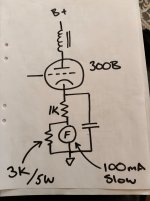when opening up a 300B SET amplifier I’ve built some years ago I found this “safety circuit”. At the time I thought this was a good idea to protect the tube and the output transformer, if something would go wrong.
Not I’m not so sure..
’ll guess it could cause inductive voltage spikes if blown
Could this fuse cause bigger problems than it protects?
The amplifier is actually a monkeystyle amplifier with 650V at B+, but here simplified to give a better understanding of the concept.
Not I’m not so sure..
’ll guess it could cause inductive voltage spikes if blown
Could this fuse cause bigger problems than it protects?
The amplifier is actually a monkeystyle amplifier with 650V at B+, but here simplified to give a better understanding of the concept.
Attachments
No it is a good way of protecting valuable stuff.
Fuses have a habit not to cause any bigger problem than they protect. The 3 kOhm helps the fuse with that task.
Fuses have a habit not to cause any bigger problem than they protect. The 3 kOhm helps the fuse with that task.
Why do you suggest that?’ll guess it could cause inductive voltage spikes if blown
The cathode current is through 1k, and then if the fuse opens it is through 4k. That likely causes the cathode voltage to increase from say 80V (80mA through 1k), to something towards 320V (80mA through 1k), but that likely causes cathode current to fall due to plate loadline. Also, any abrupt change in cathode current or voltage is suppressed by the cap, so the 'inductive voltage spike' you may be alluding to from the output transformer is likely alleviated by that cap.
But you have to consider what caused the fault, and whether the fuse could blow for starters given its characteristic and all the series path resistances from +650V, and the sag on the +650V if a fault occurred. Hopefully the amp designer went through all that and appropriately chose a suitable fuse.
